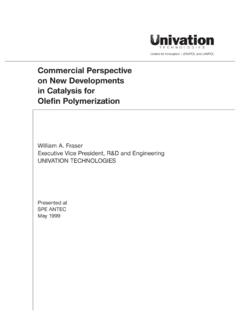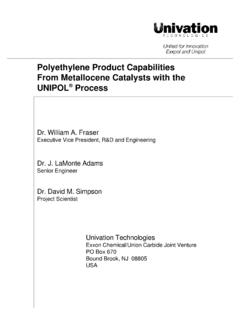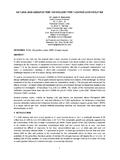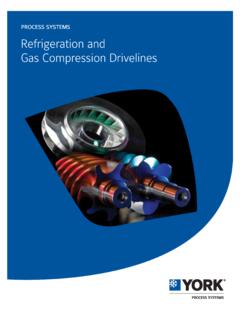Transcription of Manufacturing Efficiencies From Metallocene …
1 Manufacturing EfficienciesFrom Metallocene catalysis In Gas-PhasePolyethylene ProductionDr. William A. FraserExecutive Vice President, R&Dand EngineeringDr. Clark C. WilliamsDevelopment ScientistDr. William H. SachsSenior Research Scientist Univation TechnologiesExxon Chemical/Union Carbide Joint VenturePO Box 670 Bound Brook, NJ 08805 USA2 Manufacturing Efficiencies FROM METALLOCENECATALYSIS IN GAS-PHASE POLYETHYLENE PRODUCTIONDr. William A. Fraser, Dr. Clark C. Williams, Dr. William H. SachsUnivation TechnologiesExxon Chemical/Union Carbide Joint VentureABSTRACTM etallocene catalysis is a rich and fertiletechnology with major implications for thepolyolefins industry.
2 It is a very broad technol-ogy. Much industry symposia discussion hasfocused on the importance of this technology asa vehicle to new and better products. Metallo-cene catalyst systems also bring important proc-ess benefitsto gas-phase polyethylene production. Highcatalyst activity, signature kinetic pro-file/process response characteristics, and controlof polymer molecular architecture, together, canbe leveraged to enhance Manufacturing efficien-cies with theUNIPOL PE Process. Specific met-allocene catalyst systems provide a cas-cade of process technology benefits toUNIPOL PE sits far upstream in the technol-ogy flow of producing and using polyethyleneresins.
3 In this framework, shown in Figure 1, Metallocene catalysts control the stochasticprocesses of assembling monomers and co-monomers into polymers of distributed structureand tailored performance. The reaction system,its processMANUFACTURING Efficiencies FROM METALLOCENEC atalysisPEFabricationProcessingPEEnd-Use ApplicationPEResinProductPEProductionPro cessReactantsCompoundingAdditivesRegime of PE ProducersBuyers ofPE ResinUsers ofPE ResinFIGURE 1. CONCEPT SCHEMATIC-TECHNOLOGY FLOW IN PRODUCING AND USING POLYETHYLENE 1997 Univation TechnologiesUNIPOL is a registered trademark of Union CarbideEXXPOL is a registered trademark of Exxon Corporation3engineering and operating protocols, definesthe efficiency of this polymer assembly andthe production dynamics of resin chemistry is a powerfulmolecular engineering tool for polyethyleneproduct development.
4 It is this embodiment ofmetallocene technology, the product implica-tions of the chemistry, which has dominatedindustry symposia discussion and defined theemphasis for much R&D effort. Product devel-opment with this tool is now moving from aspecialty niche applications focus into the coreof volume PE production and the arena of com-modity markets and applications. In the applica-tion of Metallocene technology to the manufac-ture of resins with broad product functionalityfor the volume PE marketplace, economic con-siderations and Manufacturing Efficiencies be-come important drivers of technology develop-ment. To win in this commercial arena, metallo-cene catalyst capability must be integratedwith an efficient, cost effective, PE UNIPOL PE Process is the world spremier gas-phase PE production technology,now used around the world by Union Carbide,its joint ventures and 47 licensees in 74 reactorlines with an operating capacity of more than 9million TPY.
5 By 2000, 90 reactors will be pro-ducing more than 12 million TPY. UNIPOL PEprocess technology combines the lowest capitaland operating costs with a record of proven reli-ability and safety in PE Chemical and Union Carbidehave formed a joint venture company, UnivationTechnologies, to develop, market, and licenseadvanced production and process technologiesfor the manufacture of performance and eco-nomic-advantaged polyethylenes. The newventure is a technology and licensing companycommitted to driving technology renewal inthe polyethylene industry. A focus of UnivationTechnologies is to accelerate the pace of com-mercial development and broaden the globalreach of Metallocene technology applied tovolume PE aspects of catalyst performanceare critical considerations in the development ofcommercial catalysts to address the manufac-turing complexities and practicalities of volumePE production in world scale plants.
6 BothExxon Chemical and Union Carbide have de-veloped customized Metallocene catalyst sys-tems specifically for the operating regime of theUNIPOL Process for PE manufacture. Metallo-cene catalyst chemistries, custom fit to the reac-tion process, advance and broaden further theoperational scope and product capabilities of theUNIPOLPE the formation of Univation Tech-nologies, EXXPOL Metallocene catalyst sys-tems (now including complementary UCC met-allocene technology) and capacity-enhancingSuper Condensed Mode Technology (SCM-T)become fully leveraged with UNIPOL Metallocene Catalyst SystemsThere are a very large number of met-allocene catalyst systems.
7 Table 1 lists catego-ries of Metallocene precursors. The various met-allocene catalysts exhibit a wide range of kineticbehaviors and process response 1. CATEGORIES OF Metallocene CATALYSTSMANUFACTURING Efficiencies FROM METALLOCENEBis Cp Systems- Unbridged- Bridged - Si, C2, Other- Symmetric, Asymmetric- Halogen, Non-Halogen LigandsMono Cp Systems- Unbridged- Bridged- Alkyl, Non-Alkyl LigandsTransition Metals - Ti - Zr - HfActivation Systems- Alumoxanes- Non-Coordinating Anions4 Metallocene ligand structure, metal center, andactivation chemistry define the electronic andsteric environment of the catalyst system, which,in turn.
8 Establish the catalyst s regulation of thestochastic processes of monomer/comonomerinsertion and chain transfer chemistries. Electronics and sterics also define catalystkinetic profiles, , activation and decay char-acteristics which determine catalyst productiv-ity, and catalyst kinetic response to temperatureand reactant concentrations. Figure 2 shows thediffering copolymerization responses for a rangeof 2. COPOLYMERIZATION BEHAVIOR FOR SELECTED Metallocene CATALYSTSR esin density is plotted vs C6/C2 ratio for met-allocenes of different structure. Figure 3 showsthe differing chain transfer responses to H2 fora range of Metallocene systems.
9 Figure 4 showsthe very different gas-phase polymerization pro-files of three Metallocene systems which makevery similar PE Process - BasicsA UNIPOL Process overview schematicis shown in Figure 5. Growing polymer parti-cles are fluidized by a recycle gas stream ofmonomer, comonomer, hydrogen, nitrogenand inert condensing agent such as hexaneor isopentane. The cycle gas flow providesmonomer and comonomer for polymerization,agitates the bed, and also removes the heatof polymerization. The cycle gas exits thetop of the reactor and is then compressed andcooled before being fed into the bottom of thefluidized 3. CHAIN-TRANSFER-TO-HYDROGEN RESPONSE FOR SELECTED Metallocene CATALYSTSF igure 4.
10 GAS-PHASE POLYMERIZATION KINETIC PROFILES FOR SELECTED Metallocene CATALYSTSMANUFACTURING Efficiencies FROM Index (dg/min)H2/C2 Ratio (Micromole/mole) (g/cc)C6/C2 Ratio (mole/mole) ActivityTime (Seconds)XYZ5 Figure 5. PROCESS SCHEMATIC-UNIPOL GAS-PHASE REACTOR SYSTEMO lefin polymerization is a very exothermicreaction. Reaction system production rate islimited by heat removal from the cycle gas inthe cooler. For fixed engineering design, heatremoval is governed by the heat capacity, dewpoint, and temperature of the cycle /UNIPOL - Catalyst/Process/Product SynergiesIn the gas-phase fluid bed UNIPOL PEProcess, catalysis , process, and product technol-ogy interact with mutual interdependency todetermine process operability and manufactur-ing Efficiencies .












